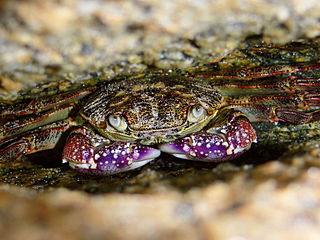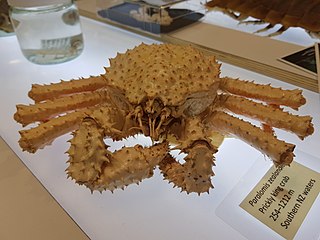 W
WAlope is a genus of shrimp in the family Hippolytidae, comprising two species:Alope orientalis is widely distributed across the Indo-West Pacific. Alope spinifrons is endemic to New Zealand, and is found throughout that country's coasts.
 W
WAustrominius modestus is a species of barnacle in the family Austrobalanidae, native to Australia, Tasmania and New Zealand, but now spread to Britain and the north west coasts of Europe. It reaches a maximum size of about 10 millimetres (0.39 in) in diameter.
 W
WBellorchestia quoyana is the largest and most common species of sandhopper, endemic to New Zealand. Its length is up to 14 millimetres (0.55 in). They help to keep the beaches clean by breaking down any organic material, which is vital for plant succession. They are nocturnal and bury themselves up to 30 centimetres (12 in) during the day.
 W
WChamaesipho brunnea is an intertidal barnacle common in New Zealand, in both the North Island and the South Island. Juveniles have six shell wall plates, reducing to four in adults, and with age, all plates become concrescent, with no trace of sutures inside or out. Shell is brown colored. The related, and sometimes associated Chamaesipho columna is much smaller in size, by nearly half, while Elminius, which can associate with both species, also has four shell wall plates, but plates remain distinct at all stages. The shell of C. columna corrodes to a pitted surface, while that of C. brunnea has a lamellar corrosion.
 W
WThe smooth shore crab, Cyclograpsus lavauxi, is a marine large-eyed crab of the family Grapsidae, found in New Zealand and the Juan Fernández Islands of Chile.
 W
WGandalfus puia is the only known New Zealand species of crab in the family Bythograeidae, commonly known as the blind vent crabs. Like other blind vent crabs, it only lives in hydrothermal vent waters. This species was first described in 2007 after specimens were collected from the undersea volcanic ridge near the Kermadec Islands.
 W
WHemigrapsus crenulatus, the hairy-handed crab or papaka huruhuru, is a marine crab of the family Varunidae, endemic to the New Zealand coast, although a taxon in Chile may be conspecific.
 W
WHemigrapsus sexdentatus, known as the common rock crab, is a large-eyed marine crab of the family Varunidae, endemic to the coasts of New Zealand. However, it is not found in the Chatham Islands or the southern islands. It can grow to around 45 millimetres (1.8 in) (female) or 55 millimetres (2.2 in) (male) shell width.
 W
WHeterozius rotundifrons, or big hand crab, is a species of crab of the family Belliidae, endemic to New Zealand. The carapace width is up to 25 millimetres (1 in).
 W
WIbacus alticrenatus is a species of slipper lobster that lives in the waters of Australia and New Zealand.
 W
WJasus edwardsii, the southern rock lobster, red rock lobster, or spiny rock lobster, is a species of spiny lobster found throughout coastal waters of southern Australia and New Zealand including the Chatham Islands. This species is commonly called crayfish or crays in both Australia and New Zealand and kōura in Māori. They resemble lobsters, but lack the large characteristic pincers on the first pair of walking legs.
 W
WLeptograpsus variegatus, known as the purple rock crab, is a marine large-eyed crab of the family Grapsidae, found in southern subtropical Indo-Pacific Oceans. It grows to around 50 millimetres (2.0 in) shell width. It is the only species in the genus Leptograpsus.
 W
WMetanephrops challengeri is a species of slim, pink lobster that lives around the coast of New Zealand. It is typically 13–18 cm (5–7 in) long and weighs around 100 g (3.5 oz). The carapace and abdomen are smooth, and adults are white with pink and brown markings and a conspicuous pair of long, slim claws. M. challengeri lives in burrows at depths of 140–640 m (460–2,100 ft) in a variety of sediments. Although individuals can live for up to 15 years, the species shows low fecundity, where small numbers of larvae hatch at an advanced stage.
 W
WThe New Zealand pea crab, Nepinnotheres novaezelandiae, is a small, parasitic crab that lives most commonly inside New Zealand green-lipped mussels. Adult females are about the size and shape of a pea, while adult males are smaller and flatter. Adult New Zealand pea crabs are completely reliant on their host mussel for shelter and food, which it steals from the mussel's gills. The New Zealand pea crab is found throughout New Zealand and can infect up to 70% of natural populations. These crabs are of concern to green-lipped mussel aquaculture because they reduce the size and growth of mussels, although infected mussels can be harvested and consumed.
 W
WNotomithrax ursus, known as the hairy seaweed crab, is a spider crab of the family Majidae.
 W
WOzius truncatus, or the black finger crab or reef crab, is a crab of the family Menippidae, endemic to south eastern Australia and the North Island of New Zealand.
 W
WPagurus novizealandiae, or the New Zealand hermit crab is a hermit crab of the family Paguridae, endemic to New Zealand. Its body is up to 16 millimetres (0.63 in) wide.
 W
WPalaemon affinis is a species of shrimp of the family Palaemonidae. Early authors used the name Palaemon affinis for specimens now known to belong to a variety of species, but P. affinis is now known to be endemic to the waters of New Zealand.
 W
WParalomis zealandica, also known as the prickly king crab, is a species of king crab which lives at a depth of 254–1,212 m (833–3,976 ft) in New Zealand. It has spiky carapace. The scientific name of the species was first validly published in 1971 by Dawson & Yaldwyn. P. zealandica can be distinguished from other species in New Zealand waters by its thick covering of strong upright spines all over, including on its abdomen and along its legs and claws. The rostrum has three short, strong and sharp spines. It is the most prominent species of Paralomis in New Zealand.
 W
WPetrolisthes elongatus, known as the New Zealand half crab, elongated porcelain crab, blue half crab, blue false crab or simply as the half crab or false crab, is a species of porcelain crab native to New Zealand.
 W
WThe pie crust crab, is a species of crab found around New Zealand and south-eastern Australia.
 W
WSagmariasus verreauxi is a species of spiny lobster that lives around northern New Zealand, the Kermadec Islands the Chatham Islands and Australia from Queensland to Tasmania. It is probably the longest decapod crustacean in the world, alongside the American lobster Homarus americanus, growing to lengths of up to 60 centimetres (24 in).
 W
WThe stalk-eyed mud crab, Macrophthalmus hirtipes, is a marine large-eyed crab of the family Macrophthalmidae, endemic to New Zealand including Campbell Island. It grows to around 30 millimetres (1.2 in) shell width. It is either the only species in the subgenus Hemiplax and the most basal species in the genus Macrophthalmus, or the only species in the sister genus Hemiplax.
 W
WThe tunnelling mud crab, Austrohelice crassa, is a marine large-eyed crab of the family Grapsidae, endemic to the sea coasts of New Zealand. Their carapace width is up to 40 mm.